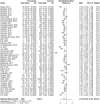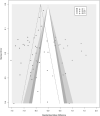Sarcopenia and health-related quality of life: A systematic review and meta-analysis
- PMID: 37139947
- PMCID: PMC10235892
- DOI: 10.1002/jcsm.13243
Sarcopenia and health-related quality of life: A systematic review and meta-analysis
Abstract
The decrease of physical abilities and functional decline that can be caused by musculoskeletal conditions such as sarcopenia, can lead to higher levels of dependency and disability. Therefore, it may influence patient reported outcome measures (PROM), such as the health-related quality of life (HRQoL). The purpose of this systematic review and meta-analysis is to provide a comprehensive overview of the relationship between sarcopenia and HRQoL. Preferred Reporting Items for Systematic Reviews and Meta-Analyses (PRISMA) were followed throughout the whole process of this work. A protocol was previously published on PROSPERO. The electronic databases MEDLINE, Scopus, Allied and Complementary Medicine (AMED), EMB Review - ACP Journal Club, EBM Review - Cochrane Central of Register of Controlled Trials and APA PsychInfo were searched until October 2022 for observational studies reporting a HRQoL assessment in both sarcopenic and non-sarcopenic individuals. Study selection and data extraction were carried out by two independent researchers. Meta-analysis was performed using a random effect model, reporting an overall standardized mean difference (SMD) and its 95% confidence interval (CI) between sarcopenic and non-sarcopenic individuals. Study quality was measured using the Newcastle-Ottawa Scale and the strength of evidence was assessed using the Grading of Recommendations Assessment, Development and Evaluation (GRADE) tool. The search strategy identified 3725 references from which 43 observational studies were eligible and included in this meta-synthesis study. A significantly lower HRQoL was observed for sarcopenic individuals compared with non-sarcopenic ones (SMD -0.76; 95% CI -0.95; -0.57). Significant heterogeneity was associated with the model (I2 = 93%, Q test P-value <0.01). Subgroup analysis showed a higher effect size when using the specific questionnaire SarQoL compared with generic questionnaires (SMD -1.09; 95% CI -1.44; -0.74 with the SarQoL versus -0.49; 95% CI -0.63; -0.36 with generic tools; P-value for interaction <0.01). A greater difference of HRQoL between sarcopenic and non-sarcopenic was found for individuals residing in care homes compared with community-dwelling individuals (P-value for interaction <0.001). No differences were found between age groups, diagnostic techniques, and continents/regions. The level of evidence was rated as moderate using the GRADE assessment. This systematic review and meta-analysis combining 43 observational studies shows that HRQoL is significantly reduced in sarcopenic patients. The use of disease-specific HRQoL instruments may better discriminate sarcopenic patients with respect to their quality of life.
Keywords: HRQoL; Older people; Quality of life; Sarcopenia.
© 2023 The Authors. Journal of Cachexia, Sarcopenia and Muscle published by John Wiley & Sons Ltd on behalf of Society on Sarcopenia, Cachexia and Wasting Disorders.
Conflict of interest statement
C.B., O.B. and J.‐Y.R. are shareholder of SARQOL SRL, a spin‐off of the University of Liege. The other co‐authors have no conflicts of interest to declare. This is a systematic review. No ethical approval, consent to participate or consent to publish is required.
Figures



References
-
- Woo T, Yu S, Visvanathan R. Systematic literature review on the relationship between biomarkers of sarcopenia and quality of life in older people. J Frailty Aging 2016;5:88–99. - PubMed
Publication types
MeSH terms
LinkOut - more resources
Full Text Sources
Medical

